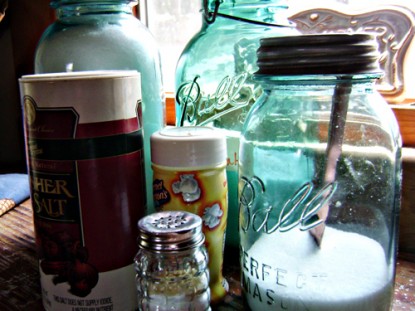
Another main ingredient in cooking and baking! Salt–or Sodium Chloride! Salt, salt, salt…as with everything there is on this earth, there are debates on sodium intake–if a high-sodium intake is harmful to you or if a low-sodium diet is harmful to you. Salt is needed in your body for it to function properly. But, of course, that is between you and your doctor. For me, it’s all about moderation–too much of anything is bad for you! Well, maybe not. I’m sure there’s something I’m not getting enough of 🙂
There are so many salts to choose from. Many can be substituted for another, but each has its own benefits. There isn’t much in the way of make-your-own substitutions with salts, just substituting one for another.
Salt is the world’s oldest food additive. It enhances other tastes–sweets taste sweeter, bitter tastes are masked (like chocolate or broccoli!)–and has played an important part in economic, religious, and warfare history as well as in foods. Did you know the word “salary” comes from salt? Roman salarium is linked to “worth their salt”.
There are refined and unrefined salts. What we eat is mostly refined. Completely raw sea salt is bitter because of magnesium and calcium compounds, so it is rarely eaten, but used in bath and cosmetics (bath salts, for example) for its magnesium and calcium benefits.
Kitchen Salts
Chemically there is little difference. They all contain 97.5% sodium chloride; however, the larger the grain, the smaller amount of sodium chloride in a given tablespoon or teaspoon. These days, salts come from all over the world, in many hues and crystal forms and textures, the difference being from where and how it’s harvested and processed. It’s used not only for taste, but for texture in baking breads and tenderizing meats, for preserving by protecting against micro-organisms which slows or prevents spoiling, and for fermenting and pickling.
- Table Salt is a very fine grained salt and is the most common–it’s what many think of when you think “salt“. Table salt is mined and is heavily processed to eliminate trace minerals. Calcium silicate (anti-caking agent) is added to give the perfect free-flowing salt we know.
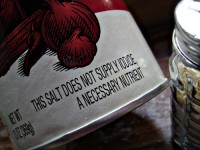 Most table salt also has added iodine, though you can buy non-iodized. Table salt is normally preferred among most bakers because it dissolves the easiest of kitchen salts.
Most table salt also has added iodine, though you can buy non-iodized. Table salt is normally preferred among most bakers because it dissolves the easiest of kitchen salts. - Popcorn Salt is a very fine grained salt, finer than regular Table Salt, that sticks to oils on the foods–popcorn, chips, french fries.
Substitute: Grind your favorite salt in a spice grinder until a very fine powder. You can add any spices you’d like right in with the salt at the same time.
- Pretzel Salt is a large-grained salt that does not melt quickly.
Substitute: A large, coarse-grained Kosher salt.
- Kosher Salt is named from making meat “kosher”. It’s harvested from either seawater or underground with no added preservatives (iodine). Some brands do add an anti-caking agent, yellow prussiate of soda. It is mostly large grained, but can be found smaller grained and flaked, which makes it a great preserving salt–its large crystals draw moisture out of meats and other foods more effectively than other salts. Many cooks use it for all of their cooking, baking, and preserving jobs–it has a more distinct flavor than table salt that can uphold heat and dissolving unlike sea salt.
Substitute: A coarse, non-iodized (make sure there are no additives) Table or Pickling/Canning Salt.
- Sea Salt is harvested from evaporated seawater and receives little or no processing, so the minerals (i.e. iron, magnesium, calcium, potassium, manganese, zinc and iodine) from the water it comes from stays. It can be found in coarse, fine and extra-fine grains and as crystals or flaked. The different minerals from the different waters will give a different flavor and a different color to the salts. Both flavor and color is lost when heated or dissolved, so most use sea salt (which is more expensive than regular table salt) as a finishing flavor. You’ll find many names of sea salts, named for the waters sources. For example, Italian Sea Salt (from the Mediterranean) and French Sea Salt (from the Atlantic).
- Pickling Salt, also called Canning Salt, is a medium-size grained salt without the iodine and anti-caking agents added. Pickling brine can be made with regular table salt, but the iodine and anti-caking agents turn pickles dark and the pickling liquid cloudy.
Substitute: Kosher Salt can be substituted for Pickling/Canning Salt. For those brands that add the anti-caking agent–this agent doesn’t cause the pickles to turn dark or cloud the liquid as table salt does.
- Rock Salt is a chunky crystal salt, most commonly used in ice cream making. It’s less refined and grayish in color and is not generally used as a salt mixed into foods, but rather as a method in cooking–to embed meat, seafood or poultry for baking. Many use it as a bed for oysters on the half shell. When using rock salt for cooking, be sure it is food-grade, some rock salt sold for ice cream machines is not suitable for cooking.
- Cheese Salt is a medium-sized grain, non-iodized salt. The medium size is important so it neither dissolves too quickly (fine grain) causing the salt to stay to the top and not mix into the cheese or too slowly (coarse grain) making the culture bacteria activity not able to be controlled.
Substitute: A medium-size grained Kosher or Pickling/Canning Salt.
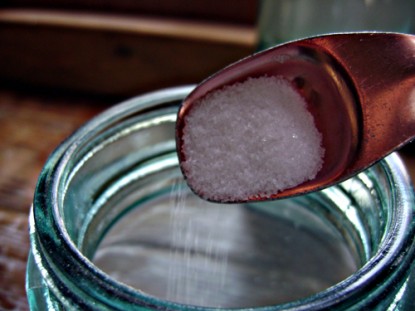
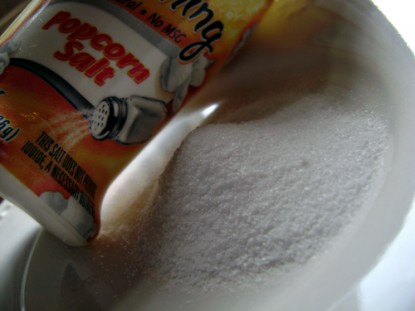
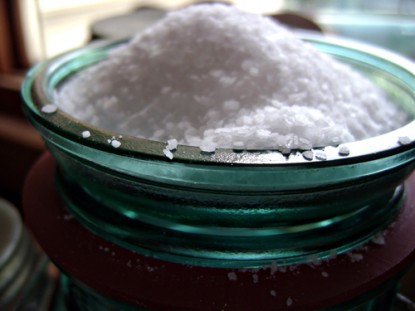
Coarse Kosher Salt
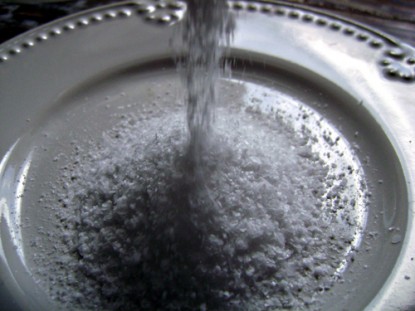
Flaked Sea Salt
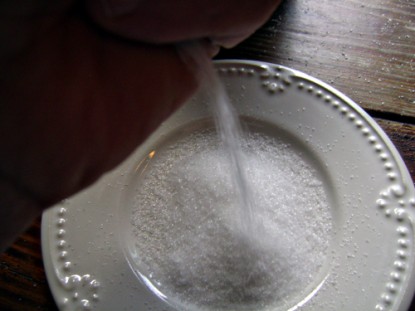
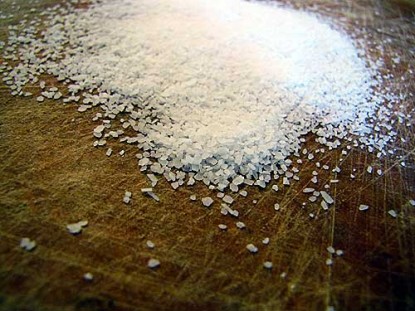
How to store salt?
Most salts can just be stored in the container you buy them in, in a cool, dry place, far from any sources of heat or sun light and in a container that can be well closed after each use.
P.S. (pre-Suzanne and this wonderful site!), that’s exactly how I did it. I only bought iodized table salt with the metal pour spout–had no use for anything else. Most of my sodium intake was from processed foods, I didn’t have use for pickling salt (or to even know I could substitute my kosher salt, if I had any, for it), baking was limited, bread-making was just a memory of my Mom’s Sunday activity. The only use I had for that pour spout was to pour it into the salt shaker in the middle of the table.

NOW! While we don’t use a lot of salt here, I do use table salt for baking, coarse kosher salt for making pretzels, canning salt for pickling and making cheese, popcorn salt for a special treat sometimes, and a flaked kosher salt in the salt shaker. All of them (except the salt for the shaker and the popcorn salt) are stored in my green Ball jars. It’s much easier to stick a measuring spoon in or pour into a cup.
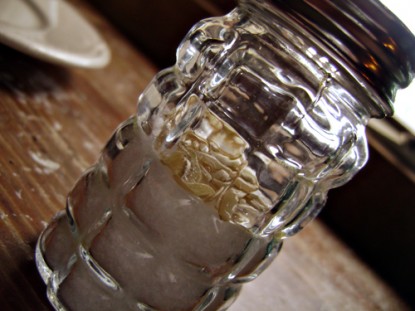
I also add a few grains of rice to the salt shaker since it’s open to the air. This is also, along with having a flaked salt in the shaker, my way of “putting one over on” John, who is on a sodium-restricted diet per the doctor. He shakes the salt shaker 5 times. Always 5 times. No matter if there was a fine salt or a coarser salt. 5 times. Having rice and a larger grain of salt makes his added salt waaay less. His sodium levels are great, says the doc.
John’s sodium restriction has been one of the reasons I’ve researched and experimented with so many substitutions. By knowing the different salts, it really helps me to keep all of our restrictions in check but still enjoy some of the “saltiness” that we love.
The salt substitutions have been updated to the Emergency Substitutions.
Cindy blogs at Chippewa Creek ~ Our Life Simplified. Do you have a recipe post or kitchen-related story to share on the Farm Bell blog? See Farm Bell Blog Submissions for information, and to submit a post.
Want to subscribe to the Farm Bell blog? Go here.




GrannyTrace says:
Wow you are soo smart. I so enjoy all your info you share Cindy!!
Thank you
Granny Trace
http://www.grannytracescrapsandsquares.com
On June 18, 2011 at 8:03 am
Robin from Rurification says:
Nice post! Thanks for the pics and great descriptions.
On June 18, 2011 at 8:16 am
Sherie says:
Thank you for that lesson – now I know why my Mom’s pickles were dark and cloudy. She always used table salt. I will get out my Kosher for pickling time. I’m glad you taught us that, or I would have been disappointed in my pickles!
On June 18, 2011 at 9:45 am
CindyP says:
Not smart, I just spend a lot of time researching when something new is thrown at me 🙂 And I figure if I’ve learned quite a bit, it could be helpful to others.
Our latest? Fats. More posts to come! LOL!
On June 18, 2011 at 10:45 am
Pam G. says:
I’ve learned, through trial and error, that Morton’s Table Salt has cornstarch included in it to keep it from clumping. I’m allergic to all forms of corn! So I now use Kosher Salt at the table. I also carry a small Tupperware container in my purse for when we are eating out. I find that I use less salt now because the Kosher Salt has a larger grain.
On June 18, 2011 at 3:17 pm
Ruthmarie says:
Like you, only recently have I started to pay attention to the differences in salt due to lifetime avoidance to additional salt seasoning in anything … the biggest shift in my cupboard was the embrace of sea salt and canning salt. Thank you for clarifying the varieties!
On June 19, 2011 at 12:20 pm